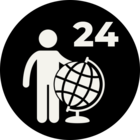I'm trying to separate many polygon features (+1mil) by another polygon boundary dataset. I'm using the spatial relator and anything with _related_candidate > 0, are exported to a file with the boundary name. It takes about 32 minutes to run. I would like to use the group by parameter and parallel processing to make this go faster except there's not a common attribute between the datasets. Is this a fruitless endeavor? Should I be happy with 32 minutes? ;)
Solved
I want to use group by in Spatial Relator but I don't have a common attribute
Best answer by takashi
Hi @tnarladni, if you can assume that each polygon is within only a single boundary (i.e. any polygon doesn't intersect two or more boundaries, or you just need to find a single boundary for a polygon even if it intersects multiple boundaries), the SpatialFilter could be faster than the SpatialRelator. For better performance, read the Filter features (boundaries) first and set 'Filters First' to the Filter Type.
Reply
Rich Text Editor, editor1
Editor toolbars
Press ALT 0 for help
Enter your E-mail address. We'll send you an e-mail with instructions to reset your password.
















